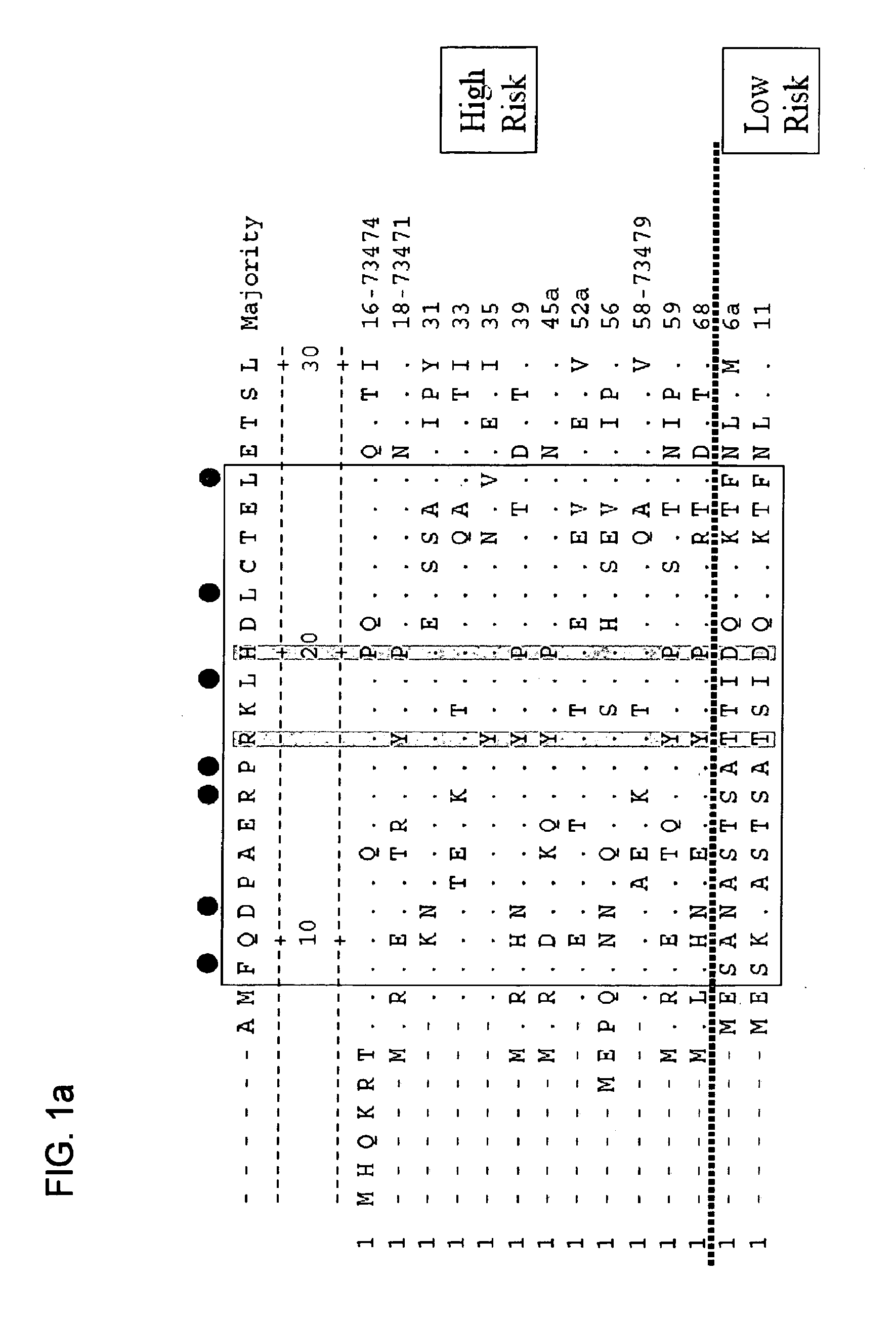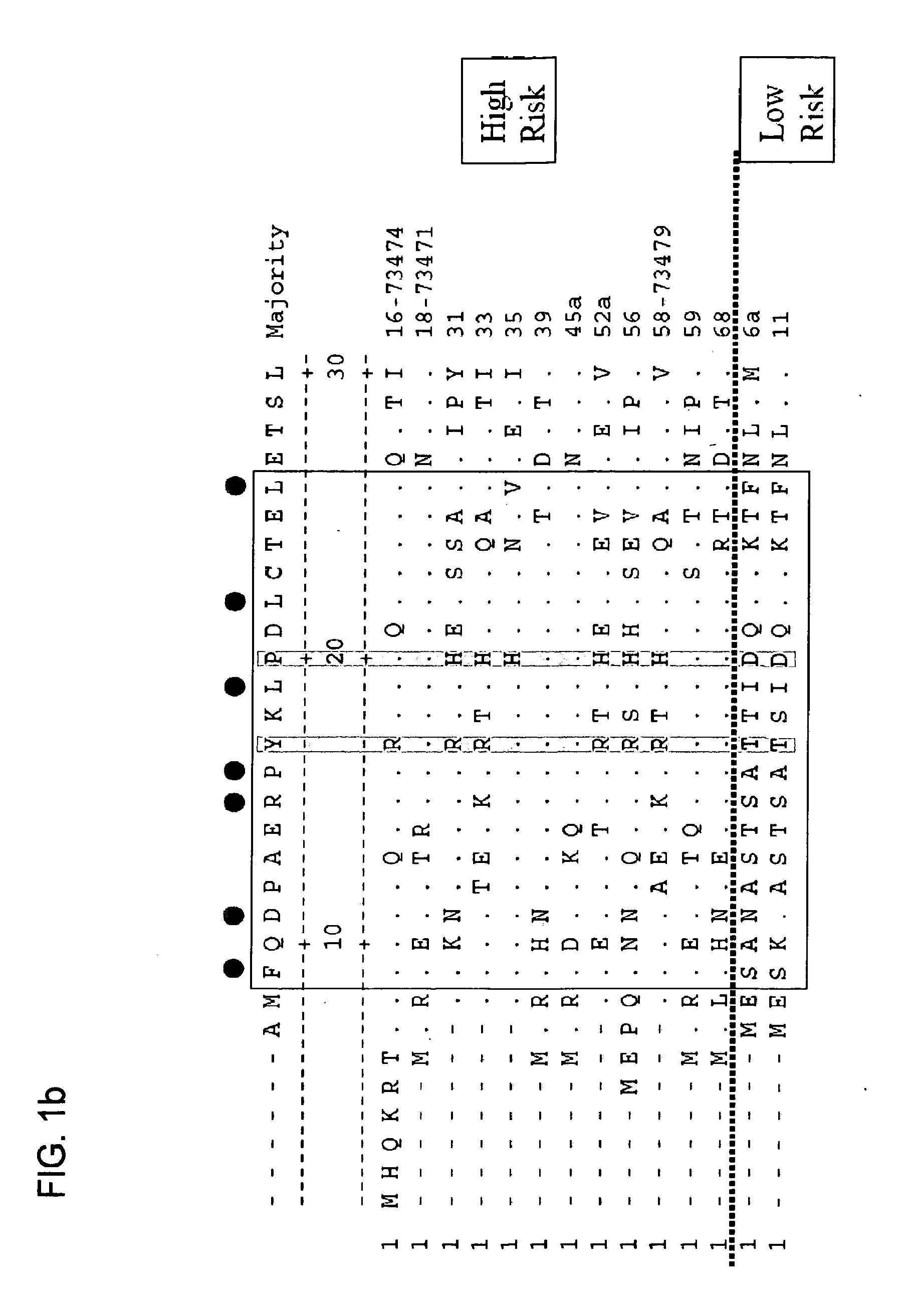Antibodies specific to e6 proteins of HPV and use thereof
a technology of hpv and antibodies, applied in the field of antibodies specific to e6 proteins of hpv, can solve the problems of 5,000 deaths each year, inability to carry out worldwide testing, and large proportion of hpv-infected persons, and achieve the effect of increasing the binding affinity and sensitivity of detecting e6 proteins and increasing sensitivity
- Summary
- Abstract
- Description
- Claims
- Application Information
AI Technical Summary
Benefits of technology
Problems solved by technology
Method used
Image
Examples
example 1
Generation of Antibodies Specific for N-terminal E6 Protein
[0249]In this example, two mAbs specific for the N -terminal E6 protein, 737BLT and 738BLT mAbs, were generated.
[0250]Mice
[0251]Female SJL mice (Taconic Hudson, N.Y.) or Balb / c mice (Charles River Laboratories Raleigh, N.C.) between 6 to 8 weeks old were obtained for use in antibody development. Mice were housed and immunized according to an approved Institutional Animal Care and Use Committee protocol.
[0252]Oncopeptide Construction
[0253]The sperm whale myoglobin amino acid sequence from 106-118 (FISEAIIHVLHSR) (SEQ ID NO: 13) was used as a foreign T cell epitope. The B cell epitopes RRETQL (SEQ ID NO: 37) or RRETQV (SEQ ID NO: 40) were derived from the C-terminus of human HPV 16 E6 and HPV 18 E6 respectively. Single onco-peptides were synthesized by New England Peptide (Gardner, Mass.) with the generic format: H2N-FISEAIIHVLHSR RRETQL-OH (SEQ ID NO: 34) or H2N-FISEAIIHVLHSR RRETQV-OH (SEQ ID NO: 38) and provided as a lyophi...
example 2
Specificity of the Subiect Antibody for HPV E6 oncopeptides
[0271]The antibodies generated by the method described in Example 1 were screened for specificity to high-risk HPV E6 oncoproteins by ELISA and Western blot. For the sandwich ELISA using hybridoma supernatant, capture mAb supernatant was diluted 1:7.5 in coating buffer and 50 pl / well was coated onto 96-well ELISA plates (Costar, Corning, N.Y.) overnight at 4° C. The plates were washed one time with PBST and wells were blocked with 300 p13% BSA / PBST for 1 hour at room temperature. The blocking solution was aspirated and 50 μl of antigen, diluted to 1 μg / ml in 1% BSA / PBST, was added to each well for 1 hour at room temperature. Detection mAb supernatant was diluted 1:7.5 in 1% BSA / PBST and incubated with horseradish peroxidase (HRP) labeled goat anti-mouse IgG-Fc antibody (Bethyl, Montgomery, Tex.) at a final concentration of 150 ng / ml at room temperature for 30 minutes. Plates were washed three times with PBST. An equal volume...
example 3
Cross-Reactivity of the Subject Antibody to High-Risk HPV E6 Proteins
[0274]The high-affinity polyclonal antibodies were put through a round of limiting dilution as described in Example 1 to generate monoclonal hybridoma cell lines. Each monoclonal antibody was tested for cross reactivity in Western blots against purified E6 proteins from multiple HPV strains, for example, HPV16, 18, 33, 31, 35, 45, 52, 56, 58, 69, 11, and 6b as shown in Table 7. Western blotting was carried out as described in Example 1. Briefly, recombinant proteins were reduced and denatured with NuPage® LDS sample buffer and sample reducing agent (Invitrogen, Carlsbad, Calif.), and then heated for 5 minutes at 95° C. Twenty micrograms of protein was separated by electrophoresis on 2D NuPage® 4-12% Bis-Tris gels (Invitrogen, Carlsbad, Calif.) with NuPage® MES SDS running buffer (Invitrogen, Carlsbad, Calif.) at 200 volts for 30 minutes. Proteins were transferred to nitrocellulose (Invitrogen, Carlsbad, Calif.) usi...
PUM
 Login to View More
Login to View More Abstract
Description
Claims
Application Information
 Login to View More
Login to View More - R&D
- Intellectual Property
- Life Sciences
- Materials
- Tech Scout
- Unparalleled Data Quality
- Higher Quality Content
- 60% Fewer Hallucinations
Browse by: Latest US Patents, China's latest patents, Technical Efficacy Thesaurus, Application Domain, Technology Topic, Popular Technical Reports.
© 2025 PatSnap. All rights reserved.Legal|Privacy policy|Modern Slavery Act Transparency Statement|Sitemap|About US| Contact US: help@patsnap.com



